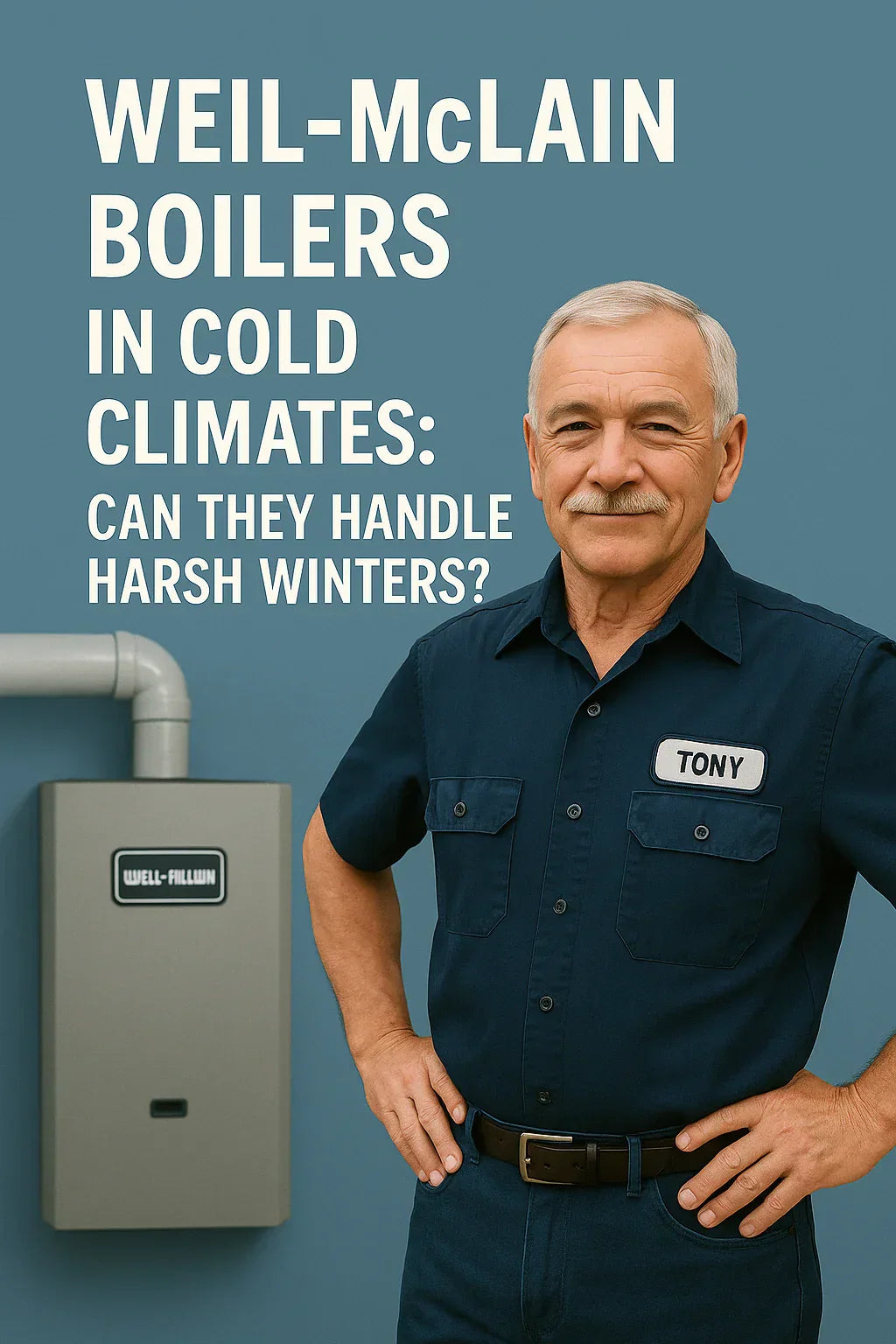🏔️ Why Choosing the Right Boiler Matters in Cold Climates
Homeowners in Zones 5-7 and northern regions need a heating system that can handle subzero temperatures without failing. Tony emphasizes that a properly sized, high-quality boiler like Weil-McLain is essential for consistent comfort, lower fuel costs, and peace of mind during harsh winters.
This guide will cover:
-
Why Weil-McLain boilers are suited for cold climates.
-
Cast iron vs. high-efficiency models in extreme cold.
-
Sizing for subzero conditions.
-
Combustion air and venting in freezing weather.
-
Maintenance to prevent winter failures.
🔥 Why Weil-McLain Boilers Perform Well in Harsh Winters
✅ Robust Engineering: Weil-McLain’s cast iron boilers are built for durability and heat retention, ideal for continuous operation in cold climates.
✅ High-Efficiency Options: Condensing models like the Evergreen and Ultra Series provide high AFUE ratings (up to 95%) while maintaining output even in frigid temperatures.
✅ Wide Range of BTU Outputs: Ensures proper sizing for homes from 1,000 sq ft cabins to 5,000 sq ft multi-story homes.
✅ Fuel Flexibility: Offers natural gas, propane, and oil-fired models for areas with limited fuel options.
For more, see Weil-McLain’s Heating Solutions.
⚙️ Cast Iron vs. High-Efficiency Condensing Boilers in Cold Climates
Cast Iron Boilers:
-
Retain heat longer and tolerate temperature swings.
-
Less susceptible to freezing damage due to larger water volume.
-
Ideal for older homes with large radiator systems.
High-Efficiency Condensing Boilers:
-
Provide fuel savings with 90-95% AFUE.
-
Require condensate management, which must be protected from freezing.
-
Work well with modern baseboard and radiant systems when sized correctly.
Tony’s Take: For extreme cold areas, cast iron models are a proven, rugged option, while condensing models can perform reliably if installed with freeze protection and proper venting.
🧮 Sizing Your Weil-McLain Boiler for Harsh Winters
Correct sizing is critical for cold climates. Oversized boilers short-cycle, while undersized systems fail to heat during extreme cold.
✅ Use Manual J Load Calculation to account for:
-
Home insulation levels.
-
Window types and air infiltration.
-
Local winter design temperatures.
✅ Typical BTU Estimates for Cold Climates:
-
35-50 BTU per sq ft depending on insulation and home tightness.
Learn more about sizing at Energy Saver’s Heating Guide.
🌬️ Combustion Air and Venting in Freezing Temperatures
✅ Ensure intake and exhaust vents are free from snow and ice blockages. ✅ Use vent termination kits designed for cold climates. ✅ Insulate condensate drain lines to prevent freezing. ✅ For sealed combustion units, ensure the intake location prevents frost buildup.
For details on venting, see Weil-McLain Installation Guidelines.
🛠️ Fuel Type Considerations for Northern Regions
✅ Natural Gas: Ideal where available due to consistent supply and lower cost. ✅ Propane: Useful for rural areas but ensure regular delivery during storms. ✅ Oil: Delivers high BTU output, reliable for off-grid homes.
Tony’s Tip: Oil boilers like the Weil-McLain WTGO Series are effective in remote cold climates, while high-efficiency gas models work well when gas supply is reliable.
🧰 Winter Maintenance Tips to Prevent Failures
✅ Schedule professional maintenance each fall to ensure combustion safety and peak efficiency. ✅ Check and clear snow around intake/exhaust vents after storms. ✅ Test thermostat and controls before peak cold arrives. ✅ Monitor system pressure and listen for unusual noises. ✅ Ensure backup power availability to run circulators during outages.
For a maintenance reference, see Energy.gov Boiler Maintenance.
🏡 Real-World Example: Tony’s Cold Climate Install
Tony installed a Weil-McLain Evergreen 220 MBH boiler in a 3,500 sq ft Vermont home with outdoor design temperatures reaching -10°F:
-
System maintained consistent 70°F indoor temperatures.
-
Propane system paired with a generator for outages.
-
Annual maintenance and insulated condensate lines prevented freeze-ups.
-
Fuel savings of ~$700 annually compared to the homeowner’s old 78% AFUE boiler.
✅ Key Takeaways
✅ Weil-McLain boilers, whether cast iron or high-efficiency, can handle harsh winter conditions if properly sized and maintained. ✅ Use freeze protection measures for condensing boilers. ✅ Select the fuel type best suited to your location and availability. ✅ Plan for annual maintenance to ensure reliable operation during winter.
🚀 Ready to Prepare Your Home for Winter?
Explore the Weil-McLain Collection at The Furnace Outlet to find a boiler suited for your climate and heating needs. Tony recommends getting your system sized and installed before winter hits to ensure comfort and reliability.
In the Next topic we will read more about: Will a Weil-McLain Boiler Fit in Your Utility Space? Clearance, Noise & Design Considerations







